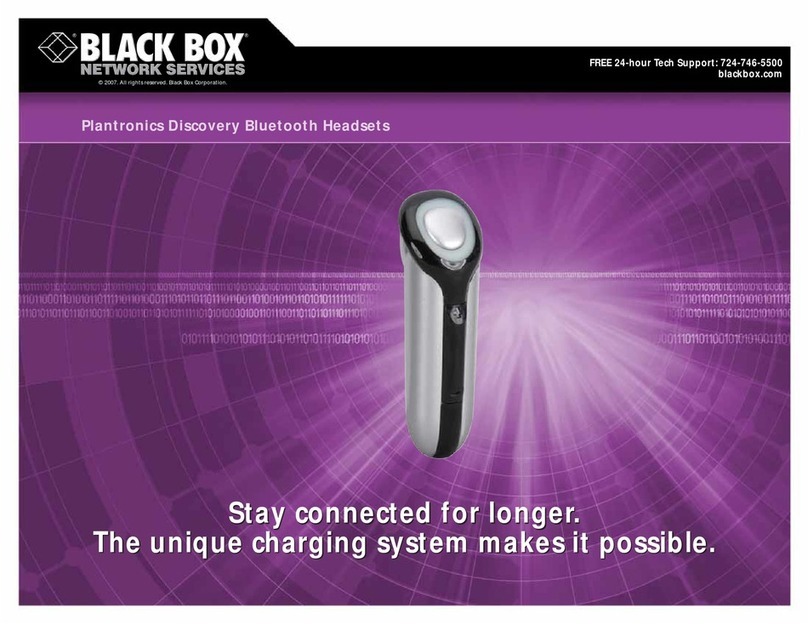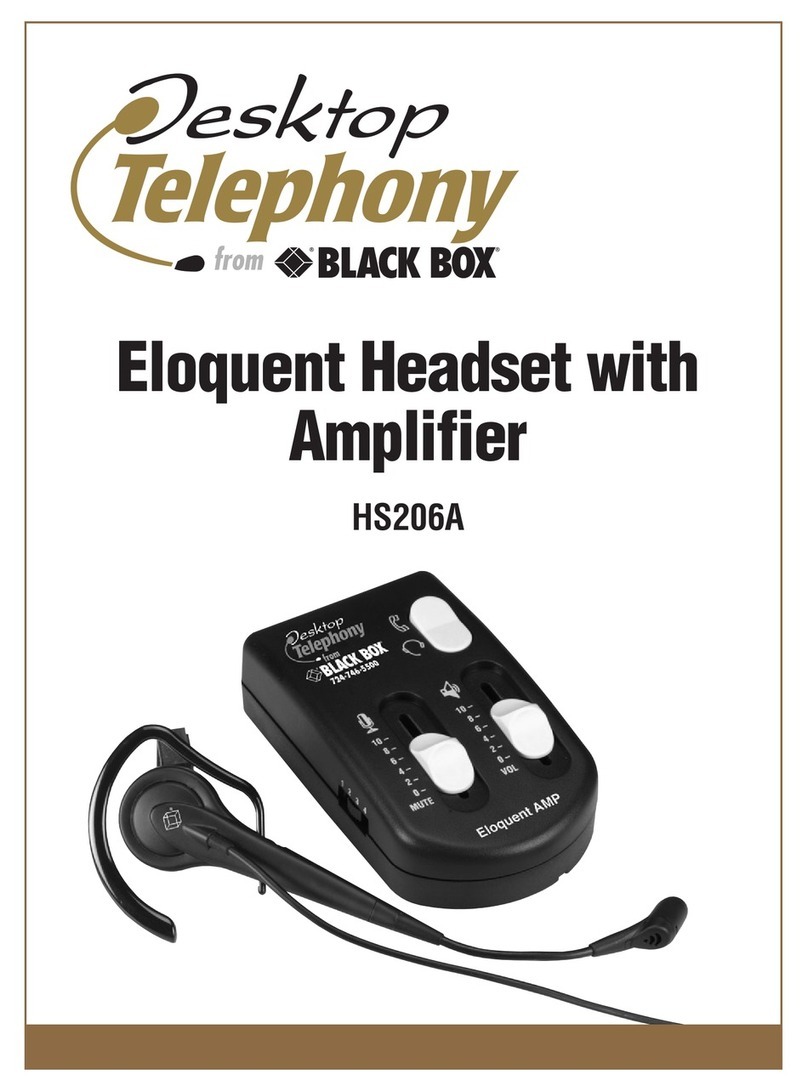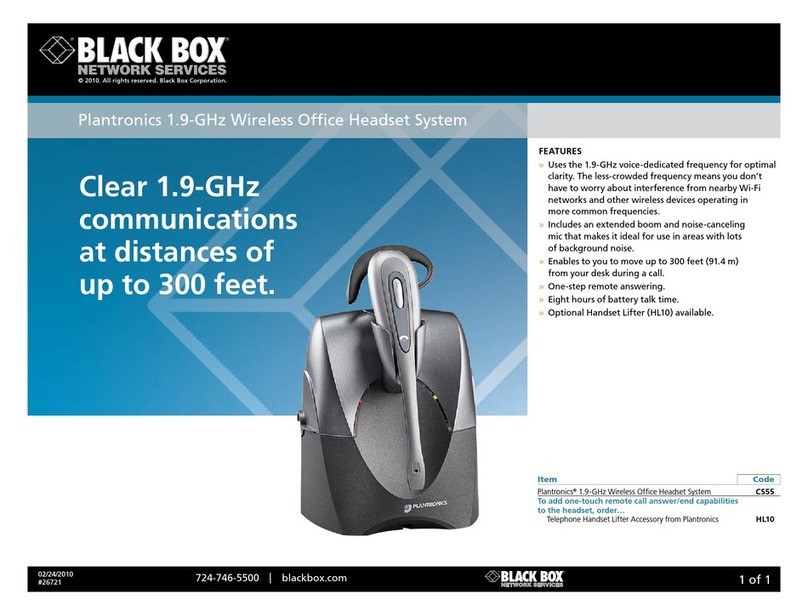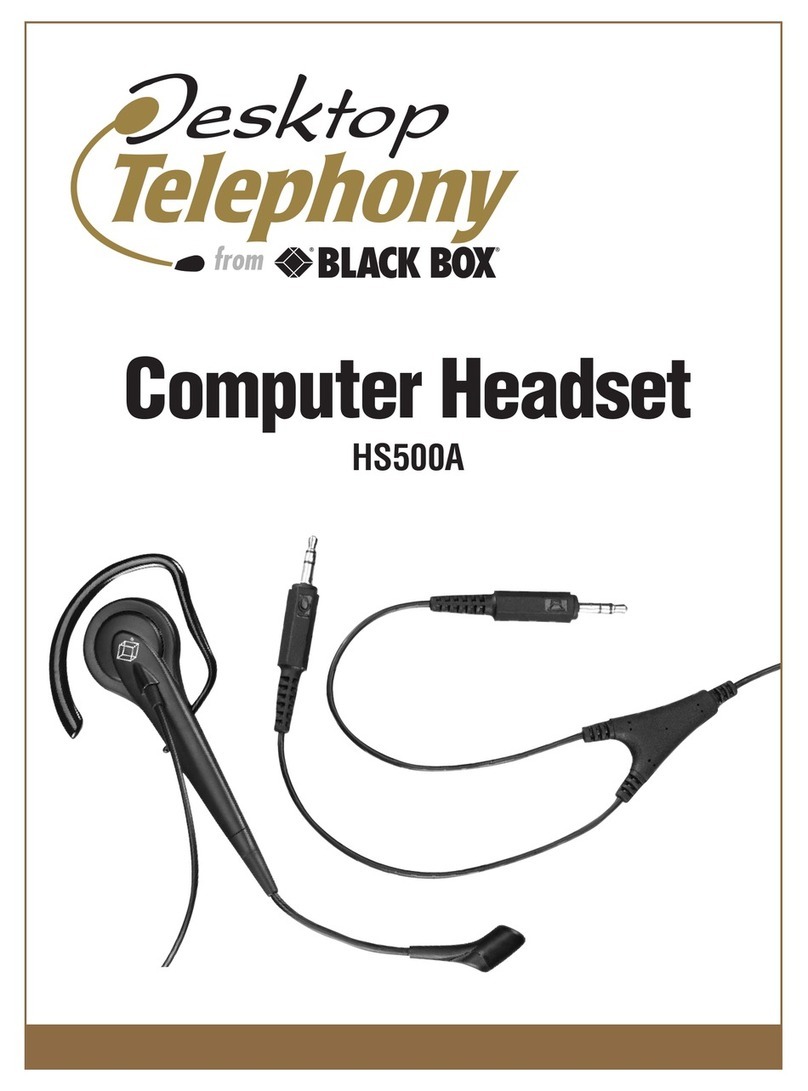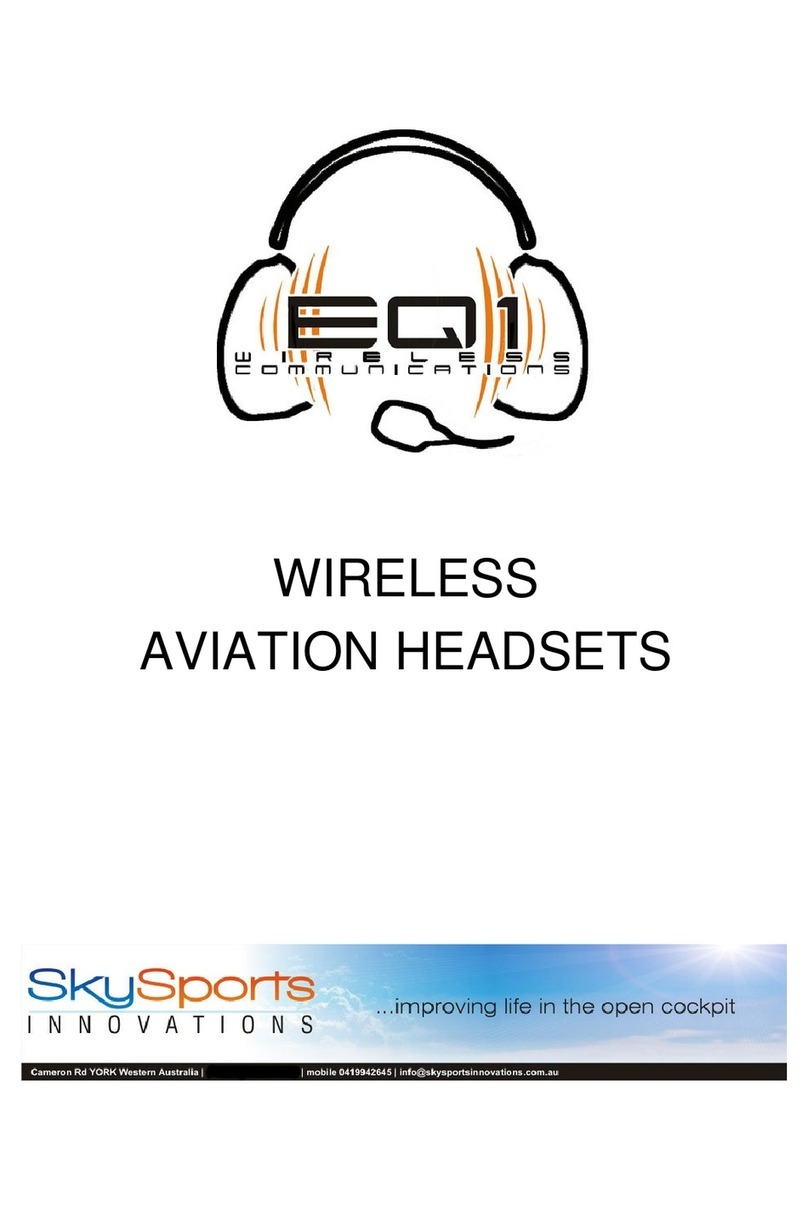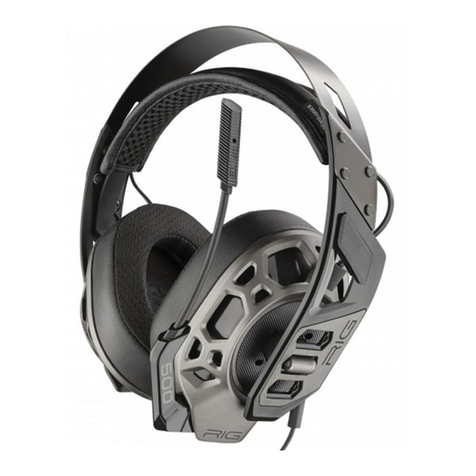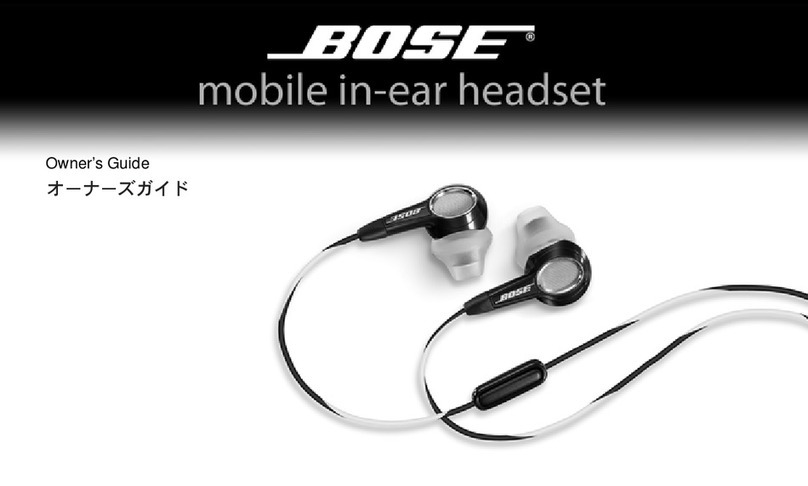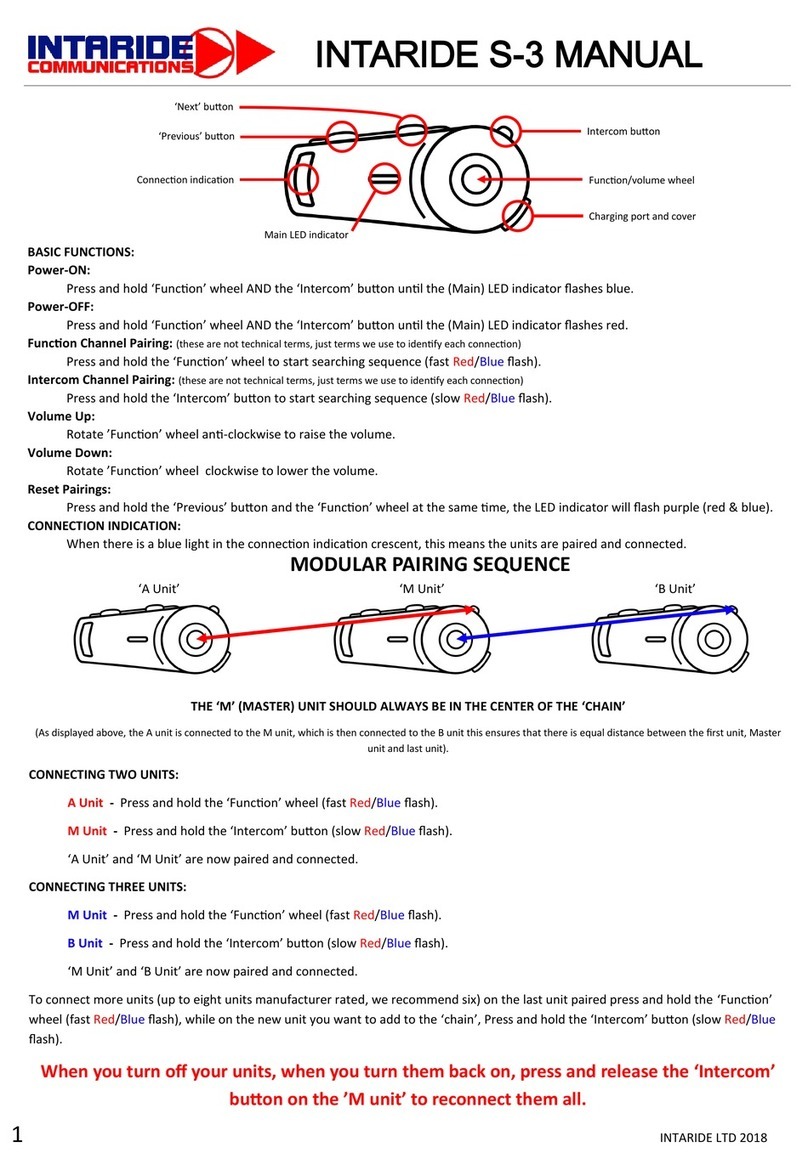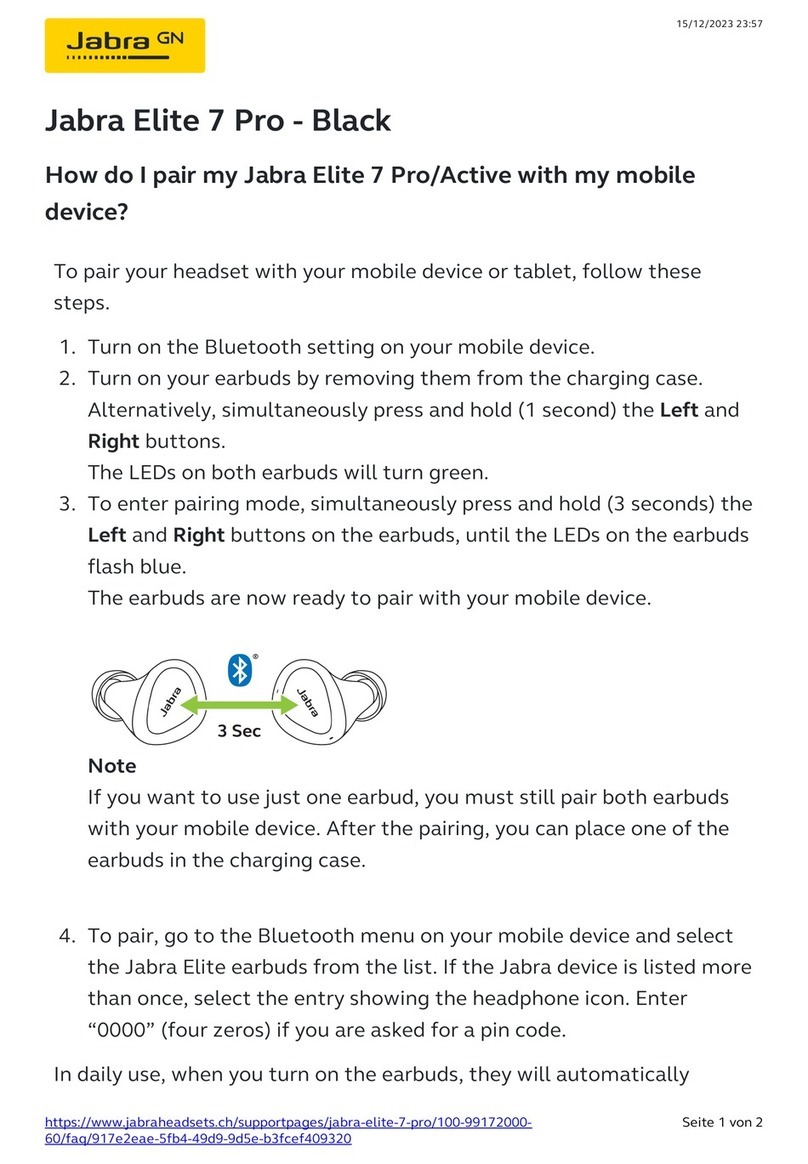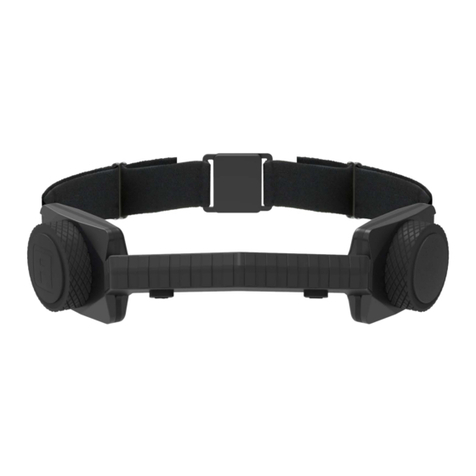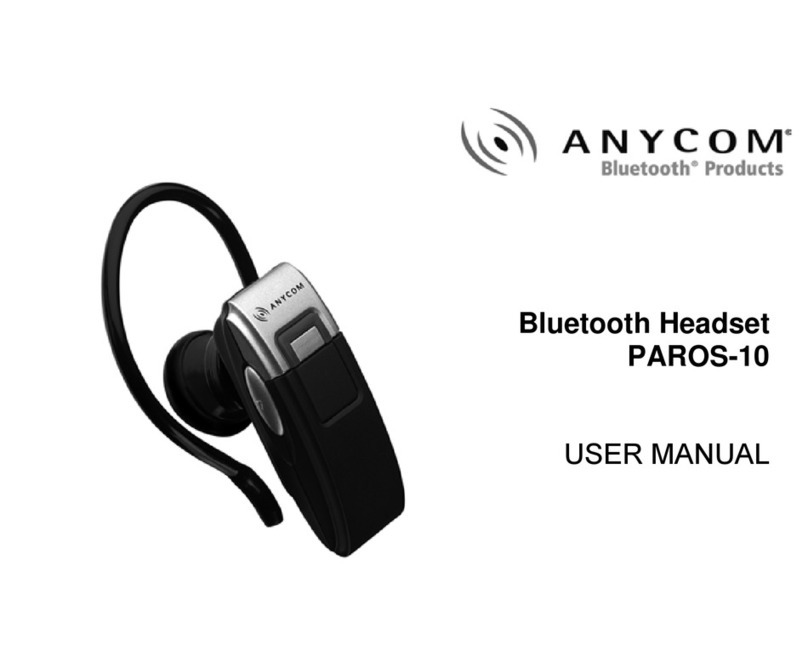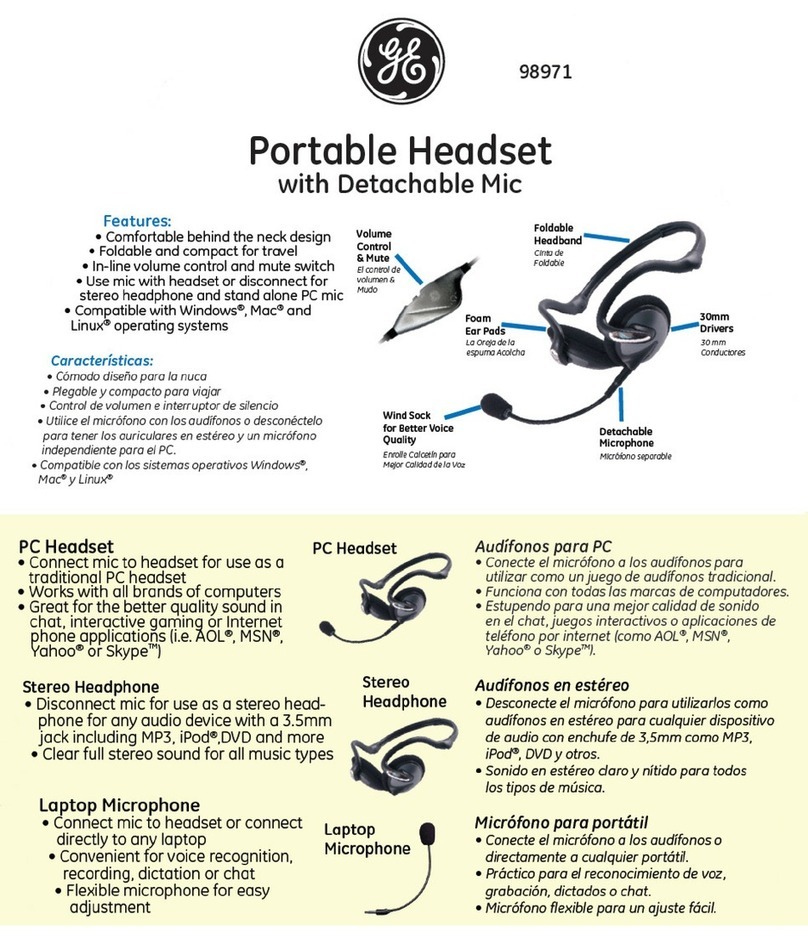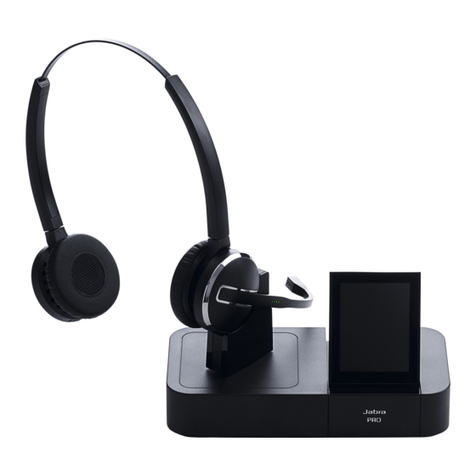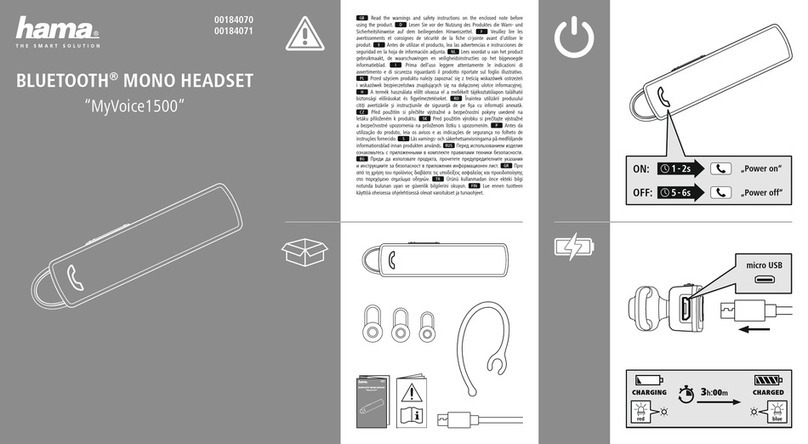Black Box Desktop Telephony HS117A User manual

Combo
Headset
HS117A

1
FCC INFORMATION
FEDERAL COMMUNICATIONS COMMISSION
AND
INDUSTRY CANADA
RADIO FREQUENCY INTERFERENCE STATEMENTS
This equipment generates, uses, and can radiate radio frequency energy and if not installed and used
properly, that is, in strict accordance with the manufacturer’s instructions, may cause interference to radio
communication. It has been tested and found to comply with the limits for a Class A computing device in
accordance with the specifications in Subpart J of Part 15 of FCC rules, which are designed to provide
reasonable protection against such interference when the equipment is operated in a commercial
environment. Operation of this equipment in a residential area is likely to cause interference, in which case
the user at his own expense will be required to take whatever measures may be necessary to correct the
interference.
Changes or modifications not expressly approved by the party responsible for compliance could void the
user’s authority to operate the equipment.
This digital apparatus does not exceed the Class A limits for radio noise emission from digital apparatus set out in the
Radio Interference Regulation of Industry Canada.
Le présent appareil numérique n’émet pas de bruits radioélectriques dépassant les limites applicables aux appareils
numériques de classe A prescrites dans le Règlement sur le brouillage radioélectrique publié par Industrie Canada.

2
COMBO HEADSET
FCC REQUIREMENTS FOR TELEPHONE-LINE EQUIPMENT
1. The Federal Communications Commission (FCC) has established rules which permit this device to be
directly connected to the telephone network with standardized jacks. This equipment should not be
used on party lines or coin lines.
2. If this device is malfunctioning, it may also be causing harm to the telephone network; this device
should be disconnected until the source of the problem can be determined and until the repair has
been made. If this is not done, the telephone company may temporarily disconnect service.
3. If you have problems with your telephone equipment after installing this device, disconnect this device
from the line to see if it is causing the problem. If it is, contact your supplier or an authorized agent.
4. The telephone company may make changes in its technical operations and procedures. If any such
changes affect the compatibility or use of this device, the telephone company is required to give
adequate notice of the changes.
5. If the telephone company requests information on what equipment is connected to their lines, inform
them of:
a. The telephone number that this unit is connected to.
b. The ringer equivalence number.
c. The USOC jack required: RJ-11C.
d. The FCC registration number.

3
CDC STATEMENT
Items (b) and (d) can be found on the unit’s FCC label. The ringer equivalence number (REN) is used
to determine how many devices can be connected to your telephone line. In most areas, the sum of the
RENs of all devices on any one line should not exceed five (5.0). If too many devices are attached, they
may not ring properly.
6. In the event of an equipment malfunction, all repairs should be performed by your supplier or an
authorized agent. It is the responsibility of users requiring service to report the need for service to the
supplier or to an authorized agent.
CERTIFICATION NOTICE FOR EQUIPMENT USED IN CANADA
The Canadian Department of Communications label identifies certified equipment. This certification means
that the equipment meets certain telecommunications-network protective, operation, and safety
requirements. The Department does not guarantee the equipment will operate to the user’s satisfaction.
Before installing this equipment, users should ensure that it is permissible to be connected to the facilities of
the local telecommunications company. The equipment must also be installed using an acceptable method of
connection. In some cases, the company’s inside wiring associated with a single-line individual service may be
extended by means of a certified connector assembly (extension cord). The customer should be aware that
compliance with the above conditions may not prevent degradation of service in some situations.
Repairs to certified equipment should be made by an authorized Canadian maintenance facility—in this case,
your supplier. Any repairs or alterations made by the user to this equipment, or equipment malfunctions,
may give the telecommunications company cause to request the user to disconnect the equipment.
Users should ensure for their own protection that the electrical ground connections of the power utility,
telephone lines, and internal metallic water pipe system, if present, are connected together. This precaution
may be particularly important in rural areas.

4
COMBO HEADSET
CAUTION:
Users should not attempt to make such connections themselves, but should contact the appropriate electric inspection authority,
or electrician, as appropriate.
The LOAD NUMBER (LN) assigned to each terminal device denotes the percentage of the total load to be
connected to a telephone loop which is used by the device, to prevent overloading. The termination on a
loop may consist of any combination of devices, subject only to the requirement that the total of the load
numbers of all the devices does not exceed 100.
NORMAS OFICIALES MEXICANAS (NOM) ELECTRICAL SAFETY STATEMENT
INSTRUCCIONES DE SEGURIDAD
1. Todas las instrucciones de seguridad y operación deberán ser leídas antes de que el aparato eléctrico
sea operado.
2. Las instrucciones de seguridad y operación deberán ser guardadas para referencia futura.
3. Todas las advertencias en el aparato eléctrico y en sus instrucciones de operación deben ser respetadas.
4. Todas las instrucciones de operación y uso deben ser seguidas.
5. El aparato eléctrico no deberá ser usado cerca del agua—por ejemplo, cerca de la tina de baño, lavabo,
sótano mojado o cerca de una alberca, etc..
6. El aparato eléctrico debe ser usado únicamente con carritos o pedestales que sean recomendados por
el fabricante.

5
NOM STATEMENT
7. El aparato eléctrico debe ser montado a la pared o al techo sólo como sea recomendado por el
fabricante.
8. Servicio—El usuario no debe intentar dar servicio al equipo eléctrico más allá a lo descrito en las
instrucciones de operación. Todo otro servicio deberá ser referido a personal de servicio calificado.
9. El aparato eléctrico debe ser situado de tal manera que su posición no interfiera su uso. La colocación
del aparato eléctrico sobre una cama, sofá, alfombra o superficie similar puede bloquea la ventilación,
no se debe colocar en libreros o gabinetes que impidan el flujo de aire por los orificios de ventilación.
10. El equipo eléctrico deber ser situado fuera del alcance de fuentes de calor como radiadores, registros
de calor, estufas u otros aparatos (incluyendo amplificadores) que producen calor.
11. El aparato eléctrico deberá ser connectado a una fuente de poder sólo del tipo descrito en el
instructivo de operación, o como se indique en el aparato.
12. Precaución debe ser tomada de tal manera que la tierra fisica y la polarización del equipo no sea
eliminada.
13. Los cables de la fuente de poder deben ser guiados de tal manera que no sean pisados ni pellizcados
por objetos colocados sobre o contra ellos, poniendo particular atención a los contactos y receptáculos
donde salen del aparato.
14. El equipo eléctrico debe ser limpiado únicamente de acuerdo a las recomendaciones del fabricante.
15. En caso de existir, una antena externa deberá ser localizada lejos de las lineas de energia.
16. El cable de corriente deberá ser desconectado del cuando el equipo no sea usado por un largo periodo
de tiempo.

6
COMBO HEADSET
17. Cuidado debe ser tomado de tal manera que objectos liquidos no sean derramados sobre la cubierta u
orificios de ventilación.
18. Servicio por personal calificado deberá ser provisto cuando:
A: El cable de poder o el contacto ha sido dañado; u
B: Objectos han caído o líquido ha sido derramado dentro del aparato; o
C: El aparato ha sido expuesto a la lluvia; o
D: El aparato parece no operar normalmente o muestra un cambio en su desempeño; o
E: El aparato ha sido tirado o su cubierta ha sido dañada.

7
TRADEMARKS USED IN THIS MANUAL
TRADEMARKS USED IN THIS MANUAL
UL®is a registered trademark of Underwriters Laboratories, Inc.
Any other trademarks mentioned in this manual are acknowledged to be the property of the trademark
owners.

8
COMBO HEADSET
Contents
1. Specifications. . . . . . . . . . . . . . . . . . . . . . . . . . . . . . . . . . . . . . . . . . . . . . . . . . . . . . . . . . . . . . . . . . . 9
2. Introduction . . . . . . . . . . . . . . . . . . . . . . . . . . . . . . . . . . . . . . . . . . . . . . . . . . . . . . . . . . . . . . . . . . 10
2.1 Description. . . . . . . . . . . . . . . . . . . . . . . . . . . . . . . . . . . . . . . . . . . . . . . . . . . . . . . . . . . . . . . . . 10
2.2 Components. . . . . . . . . . . . . . . . . . . . . . . . . . . . . . . . . . . . . . . . . . . . . . . . . . . . . . . . . . . . . . . . 10
3. Installation . . . . . . . . . . . . . . . . . . . . . . . . . . . . . . . . . . . . . . . . . . . . . . . . . . . . . . . . . . . . . . . . . . . . 11
3.1 Connecting to Your Telephone . . . . . . . . . . . . . . . . . . . . . . . . . . . . . . . . . . . . . . . . . . . . . . . . 11
3.2 Inserting the Battery . . . . . . . . . . . . . . . . . . . . . . . . . . . . . . . . . . . . . . . . . . . . . . . . . . . . . . . . . 12
3.3 Setup. . . . . . . . . . . . . . . . . . . . . . . . . . . . . . . . . . . . . . . . . . . . . . . . . . . . . . . . . . . . . . . . . . . . . . 13
3.3.1 Step 1: Adjusting to Your Telephone . . . . . . . . . . . . . . . . . . . . . . . . . . . . . . . . . . . . . . . . 13
3.3.2 Step 2: Adjusting the Microphone Sound Level . . . . . . . . . . . . . . . . . . . . . . . . . . . . . . . 14
4. Using the Headset . . . . . . . . . . . . . . . . . . . . . . . . . . . . . . . . . . . . . . . . . . . . . . . . . . . . . . . . . . . . . . 16
4.1 Answering and Making Calls . . . . . . . . . . . . . . . . . . . . . . . . . . . . . . . . . . . . . . . . . . . . . . . . . . 16
4.2 Adjusting the Receive Volume . . . . . . . . . . . . . . . . . . . . . . . . . . . . . . . . . . . . . . . . . . . . . . . . . 16
4.3 Muting the Microphone . . . . . . . . . . . . . . . . . . . . . . . . . . . . . . . . . . . . . . . . . . . . . . . . . . . . . . 17
4.4 AVS (Advanced Voice Shaping). . . . . . . . . . . . . . . . . . . . . . . . . . . . . . . . . . . . . . . . . . . . . . . . 17
4.5 Adjusting for Your Comfort . . . . . . . . . . . . . . . . . . . . . . . . . . . . . . . . . . . . . . . . . . . . . . . . . . . 17
5. Troubleshooting . . . . . . . . . . . . . . . . . . . . . . . . . . . . . . . . . . . . . . . . . . . . . . . . . . . . . . . . . . . . . . . 20
5.1 Problems and Solutions . . . . . . . . . . . . . . . . . . . . . . . . . . . . . . . . . . . . . . . . . . . . . . . . . . . . . . 20
5.2 Calling Black Box . . . . . . . . . . . . . . . . . . . . . . . . . . . . . . . . . . . . . . . . . . . . . . . . . . . . . . . . . . . 20
5.3 Shipping and Packaging . . . . . . . . . . . . . . . . . . . . . . . . . . . . . . . . . . . . . . . . . . . . . . . . . . . . . . 22
5.4 Cautionary Notes to Computer Users . . . . . . . . . . . . . . . . . . . . . . . . . . . . . . . . . . . . . . . . . . . 22

9
CHAPTER 1: Specifications
1. Specifications
Receive:
Speaker—Dynamic
Input Impedance—300 ohms
Frequency Response—300 to
3000 Hz
Automatic Gain Control
(AGC)—30 dB
Volume Control Range—
24 dB in 3 dB increments
Maximum Output—114 dB
Transmit:
Microphone—Noise-
canceling electret
Frequency Response—300 to
3000 ohms
Distortion—Less than 5%
Current Consumption—10 to
120 mA
Operating Voltage—3 V
General:
Compliance—UL®1459, FCC
Part 68
Operating Temperature—32
to 122°F (0 to 50°C)
Polarity—Non-polar
Dielectric Withstand
Voltage—7 kv
Mute—Push on/off switch,
50 dB minimum
Battery—Lithium 3 V CR3032
or DL CR2032
Battery Life—600 hours
(CR3032), 200 hours
(CR2032)
Weight—2.4 oz. (68 g)

10
COMBO HEADSET
2. Introduction
2.1 Description
The Combo Headset with built-in
amplifier and headset/handset
switch features:
• Universal telephone
interface for compatibility
with most domestically
available phone systems.
• Flexible, non-kink
microphone boom.
• Voice-shaping technology
for clear conversations.
• Click-stop headband for
comfort.
2.2 Components
A. Adjustable Headband
B. Stabilizer Cushion
C. Receiver Housing
1. Volume Control
2. Mute Button
3. Ear Cushion Mounted on
Earplate
D. Flexible Microphone Boom
E. Microphone with Foam
Cover
F. Battery
G. Battery Adapter
H.Quick Disconnect Coil Cord
I. Clothing Clip
J. Wall Hook
K. Headset/Handset Switch
Figure 2-1. Components.
A
BC
1
2
3
D
E
F
G
H
I
J
K

11
CHAPTER 3: Installation
3. Installation
3.1 Connecting to Your Telephone
1. First, connect the headset
cord to the Quick
Disconnect coil cord
(Figure 3-1).
Figure 3-1. Connecting the Headset Cord
to the Quick Disconnect.
2. If your telephone has a
socket for a headset
connection, insert the
modular plug at the end of
the headset cord into the
headset port on the
telephone. If your
telephone does not have a
port for a headset
connection, disconnect the
handset cord from the
telephone. Insert the
modular plug at the end of
the headset cord into the
handset port. (Figure 3-2).
Figure 3-2. Inserting the Modular Plug.
3. If you have purchased the
optional headset/handset
switch, install by following
these steps (Figure 3-3):
a. Connect the headset to the
headset port on the switch.
b. Connect the cord from the
handset to the handset port
on the switch.
c. Connect the handset port
on your telephone to the
telephone port on the
switch with the modular
cord provided with the
switch.
d. Select the headset or
handset mode as needed.
Figure 3-3. Installing the Headset/Handset
Switch.
WARNING
The headset contains its own
built-in amplifier circuit. Do not
connect the headset to any
headset amplifier. The headset

12
COMBO HEADSET
is equipped with a quick
disconnect for convenience
only.
3.2 Inserting the Battery
1. The battery chamber is
located on the side of the
receiver. To open the
battery chamber, use your
fingernail to pull the small
flap up (Figure 3-4).
Figure 3-4. Opening the Battery Chamber.
2. When the flap is open,
remove the chamber from
the headset (Figure 3-5).
Figure 3-5. Removing the Chamber from
the Headset.
3. Insert the battery in the
chamber with plus (+) side
of battery facing the plus (+)
side of chamber
(Figure 3-6).
Figure 3-6. Inserting the Battery into the
Chamber.
4. Put the battery chamber
back into the headset
(Figure 3-7). When it is time
to replace the battery, a
warning signal will sound in
your headset every
10 seconds.
Figure 3-7. Putting the Battery Chamber
Back into the Headset.
5. The headset ships with high-
capacity batteries. A smaller
battery can also be used.
Call Technical Support for
details. If using the alternate
battery type, insert the
enclosed blue battery
adapter into the battery
chamber (Figure 3-8).

13
CHAPTER 3: Installation
Figure 3-8. Inserting the Battery Adapter
into the Battery Chamber.
NOTE
Battery life varies with usage.
The typical life of the 3032
battery is 600 hours. The
typical life of the 2032 battery
is 200 hours.
3.3 Setup
IMPORTANT
You must complete the follow-
ing two steps before operation.
You only need to follow these
steps once for your phone. If,
however, you use a different
phone, you will need to repeat
these steps.
3.3.1 S
TEP
1: A
DJUSTING TO YOUR
TELEPHONE
1. To set up the headset to
your telephone, you need to
adjust the termination
switch. To do so, remove the
earplate and ear cushion
from the receiver by turning
the earplate 45° counter-
clockwise. The telephone
termination switch, marked
A – G, is now visible (Figure
3-9).
Figure 3-9. Telephone Termination Switch.
2. Press and hold the mute
button on the outside of the
receiver for 3 seconds. After
3 seconds you will hear a
signal indicating the headset
is now in setup mode
(Figure 3-10).
Figure 3-10. Pressing the Mute Button.
3. Put the headset receiver to
your ear. Lift the handset
from the telephone and
listen for a dial tone in your
headset.
4. If you hear a dial tone, blow
into the microphone. If you
can hear the sound of your
blowing, the setting is
correct.
A
B
CDE
F
G

14
COMBO HEADSET
5. If there is no dial tone or
you cannot hear the sound
of your blowing, move the
switch through positions A-
G until you can hear a dial
tone and the sound of your
blowing. Most phones will
use Position A (Figure 3-11).
Figure 3-11. Position A.
6. Press the mute button on
the outside of the receiver
to exit the headset set-up
mode. (If you forget, the
headset will automatically
exit the setup mode after 10
seconds.) A signal will
indicate that you are exiting
setup mode. If the headset
exits setup mode before you
have found the correct
setting, you need to enter
setup mode again as
described (Figure 3-10).
Figure 3-12. Replacing the Earplate and
Ear Cushion.
7. Put the earplate back in
place by mounting it at a 45°
angle to the right. Then
press the earplate down and
turn it clockwise (Figure
3-12).
3.3.2 S
TEP
2: A
DJUSTING THE
MICROPHONE SOUND LEVEL
The microphone sound level must
be set according to your model of
telephone for the party on the
other end to hear you clearly. This
typically only needs to be adjusted
once during set-up.
1. Put on the headset. Call
someone and ask for help
adjusting the sound level of
your microphone.
2. Press and hold mute button
for 3 seconds to enter set-up
mode. You will hear a signal
when the headset is in the
setup mode (Figure 3-13).
A
B
CDE
F
G

15
CHAPTER 3: Installation
Figure 3-13. Pressing the Mute Button.
3. Increase or decrease
microphone volume by
pressing the upper (+) or
lower (-) part of the oval
volume control button until
the other person hears you
clearly. You will hear a signal
each time you adjust the
volume. When you reach
the maximum and
minimum sound levels, you
will also hear a signal
(Figure 3-14).
Figure 3-14. Adjusting the Microphone
Volume.
4. Press the mute button again
to exit the setup mode. If
you forget, the headset will
automatically exit the setup
mode after 10 seconds
(Figure 3-13).
+

16
COMBO HEADSET
4. Using the Headset
After you have completed Steps 1
and 2 described in Sections 3.3.1
and 3.3.2, you are now ready to
use your headset.
4.1 Answering and Making Calls
1. To answer or make a call,
put on the headset, remove
the handset from its cradle,
and press the mute or the
volume button.
2. To end a call, replace the
handset in its cradle.
IMPORTANT: A
CTIVATING THE
BATTERY FROM POWER
-
SAVE MODE
1. To save battery power, your
headset is designed to
reduce power consumption
when the headset is not in
use. If your headset has
gone for 3 minutes without
use, it will automatically go
from full power or “active”
mode to “stand-by” mode. It
will stay in stand-by mode
for 30 minutes. If the unit is
not reactivated within the
30 minute period, it will
automatically drop to
“sleep” mode (a further
power reduction from the
stand-by mode)
2. A dial tone or sound on the
telephone line will
automatically reactivate
from stand-by mode. To
manually reactivate from
stand-by mode, or to
reactivate from the sleep
mode, press the mute or
volume buttons
(Figure 4-1).
Figure 4-1. Mute and Volume Buttons.
4.2 Adjusting the Receive Volume
1. To turn the headset sound
volume up or down, press
the upper (+) or lower (-)
part of the oval volume
control button until you
find the desired level. When
you reach the maximum or
minimum sound level, you
will hear a signal (Figure
4-2).

17
CHAPTER 4: Using the Headset
Figure 4-2. Adjusting the Sound Volume.
4.3 Muting the Microphone
1. To talk without the other
party hearing you, press the
mute button on the outside
of the receiver. When the
microphone is muted, you
will hear a signal every
3 seconds. When the mute
function is on, you can still
hear the other party.
4.4 AVS (Advanced Voice Shaping)
1. AVS enhances sound when
calls are difficult to hear
because of background
noise. With AVS, you
optimize the sound of the
other person’s voice. To
activate, simultaneously
press on the upper and
lower part of the volume
button. You will hear a
signal when AVS is activated
and deactivated. To cancel
the setting, just press the
volume button again in the
same manner (Figure 4-2).
4.5 Adjusting for Your Comfort
1. You can wear the headset on
your right or left ear,
whichever side you prefer.
To switch sides, simply
rotate the microphone
boom below the headband.
NOTE
Do not force the boom over
the top of the headset (Figure
4-3).
Figure 4-3. Rotating the Microphone
Boom.
2. Adjust the length of the
headband so the headset
rests comfortably on your
head (Figure 4-4). The
stabilizer cushion should be
placed just above the ear on
the side of your head
opposite the speaker.

18
COMBO HEADSET
Figure 4-4. Adjusting the Length of the
Headband.
3. Adjust the flexible
microphone boom so the
microphone is positioned
approximately 1/2” (12
mm) from your mouth
(Figure 4-5).
Figure 4-5. Adjusting the Microphone
Boom.
4. To relieve the weight of the
cord, attach the clip to your
shirt or jacket (Figure 4-6).
Figure 4-6. Clothing Clip.
5. The Quick Disconnect
allows you to be mobile
without removing your
headset. Disconnecting at
the Quick Disconnect
during a telephone call puts
your call on hold and allows
you to move away from the
phone. When you
reconnect, you are back to
your call (Figure 4-7).
Figure 4-7. Reconnecting the Quick
Disconnect.
6. To clean or change the
microphone cushion, just
pull it off gently.
7. To change or clean the ear
cushion, first remove the
earplate and ear cushion by
turning the earplate 45°
counter-clockwise. Once
removed, the ear cushion
can be taken off the earplate
(Figure 4-8).

19
CHAPTER 4: Using the Headset
Figure 4-8. Removing the Ear Cushion.
Table of contents
Other Black Box Headset manuals
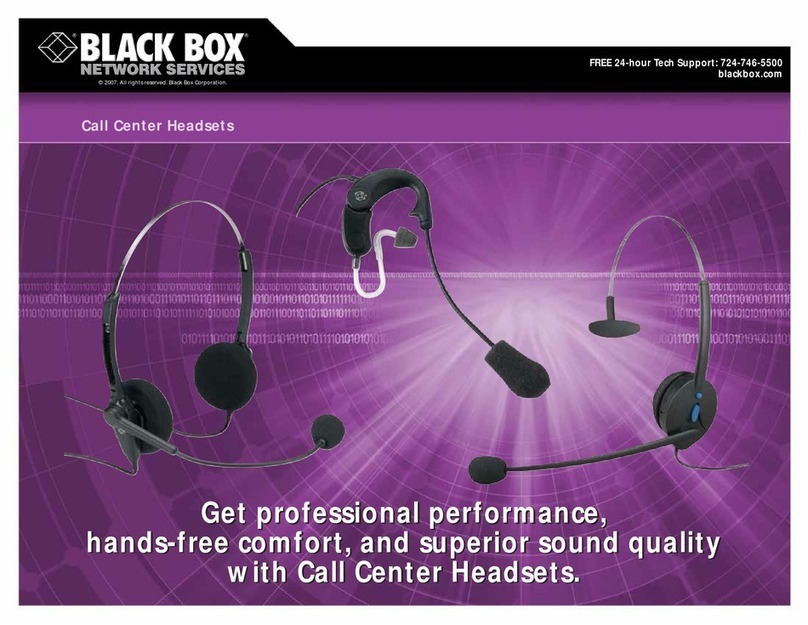
Black Box
Black Box HS111A User manual

Black Box
Black Box HS300A User manual
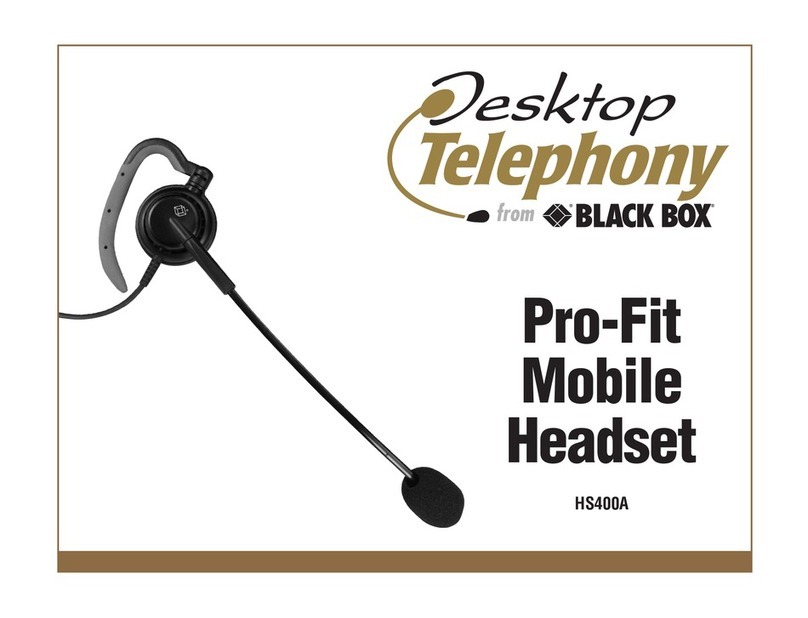
Black Box
Black Box HS400A User manual
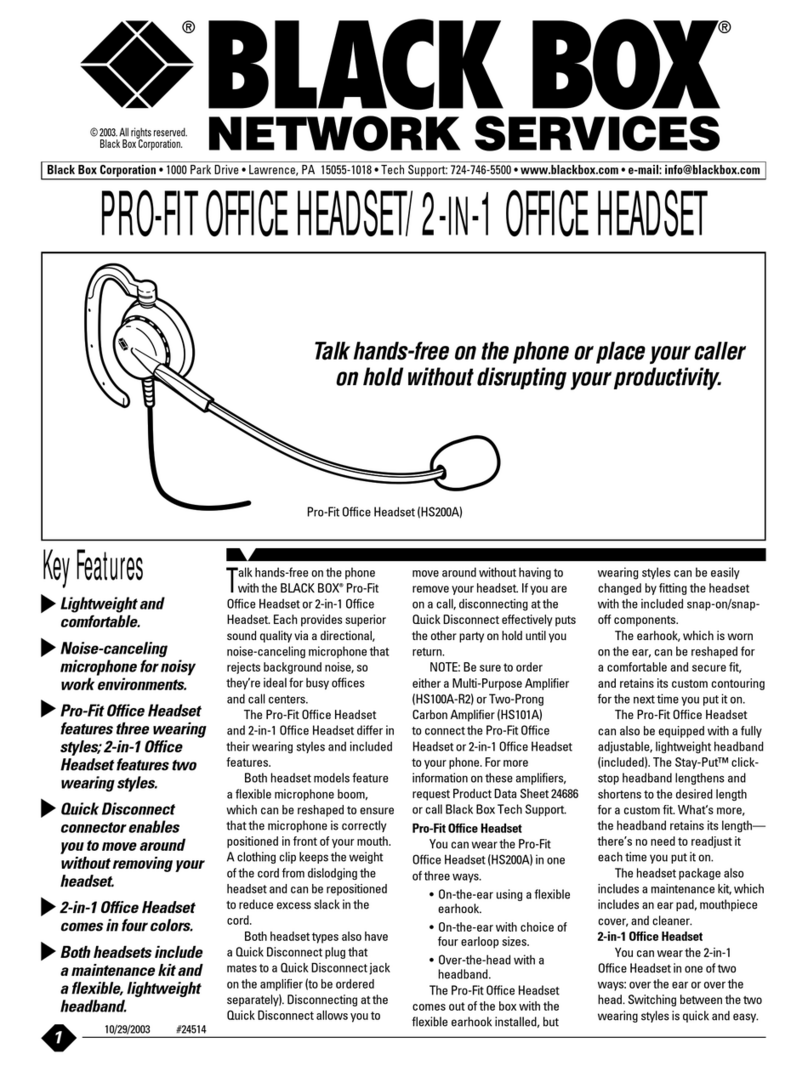
Black Box
Black Box HS200A User manual
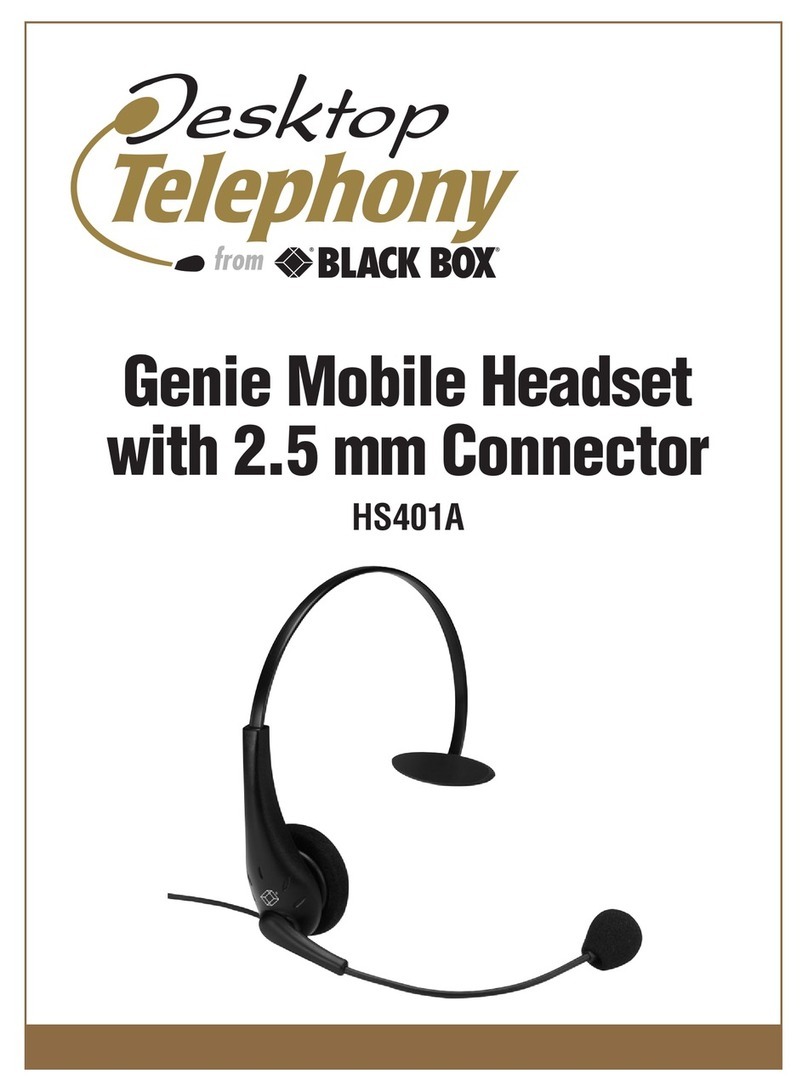
Black Box
Black Box HS401A User manual

Black Box
Black Box HS403A User manual
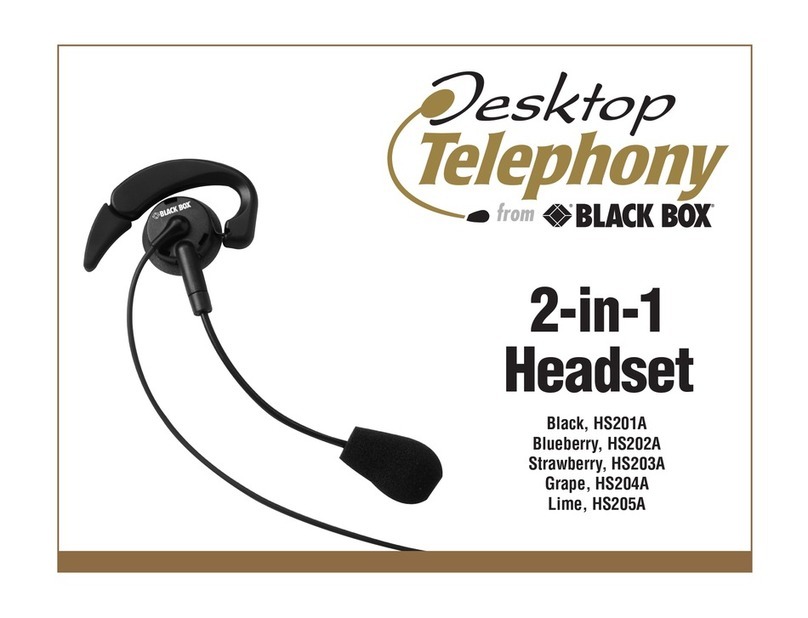
Black Box
Black Box HS201A User manual
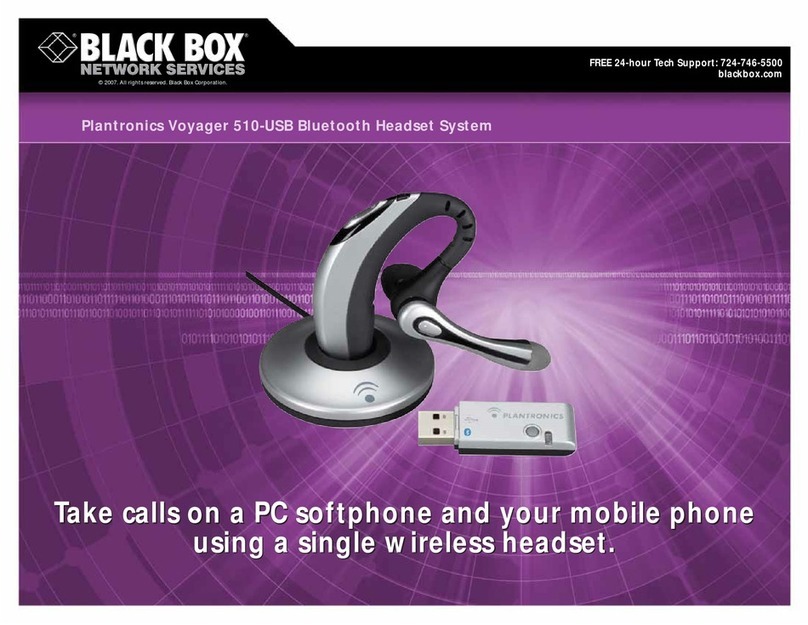
Black Box
Black Box Plantronics Voyager 510-USB User manual
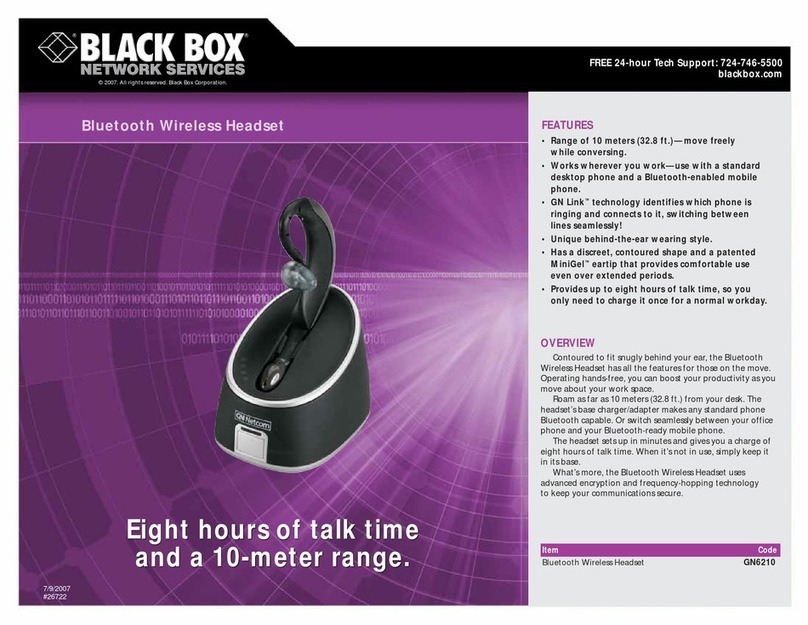
Black Box
Black Box GN6210 User manual

Black Box
Black Box HS200A User manual
